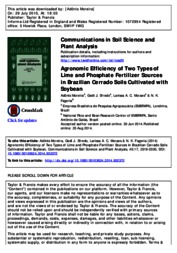Agronomic efficiency of two types of lime and phosphate fertilizer sources in Brazilian Cerrado soils cultivated with soybean.
Agronomic efficiency of two types of lime and phosphate fertilizer sources in Brazilian Cerrado soils cultivated with soybean.
Author(s): MOREIRA, A.; SFREDO, G. J.; MORAES, L. A. C.; FAGERIA, N. K.
Summary: With the increase in phosphate fertilizer prices, there is a need to find lower-cost alternatives that are as efficient as soluble sources such as single (SSP) and triple superphosphate (TSP). In Brazil?s northern and northeastern regions, there are reserves of igneous rocks with low solubility containing high concentrations of total phosphorus (P) that can be used to produce fertilizers, such as thermalphosphates. To assess the efficiency of sources of P and two types of lime on soybean yield, a field experiment was carried out in an area with dystrophic Red Latosol (Oxisol) in a Cerrado region in the southern part of Maranhão State. The experimental design was randomized blocks in a 2 × 3 × 4 factorial scheme, with four replicates. The treatments were two types of lime [calcitic (CL) (<5 dag kg-1 of MgO) and dolomitic (DL) (>13 dag kg-1 of MgO)], three phosphate fertilizer sources [triple superphosphate (TSP), ?Yoorin? thermalphosphate (YT), and experimental thermalphosphate (ET)], and four rates of phosphorus pentoxide (P2O5; 0, 100, 200, and 300 kg ha-1). After 2 years of cultivation, the application of DL resulted in greater soybean yields than the application of CL. The two lime types influenced the pH, carbon (C), calcium (Ca), and magnesium (Mg) concentrations as well as the Ca/Mg, Ca/K, and Mg/K ratios in the soil. With respect to sources of P, the YT applied in the soil with DL produced an agronomic efficiency index (AEI) similar to that of TSP, whereas in the soil with CL, the TSP, YT, and ET were similar, with maximum technical efficiency (MTE) under both conditions starting at 230 kg ha-1 of P2O5. The critical concentration of available phosphorus (P) in the soil (Mehlich-1 extractant) for cultivation of soybean under the climate and soil conditions studied was between 5.0 and 6.0 mg kg-1.
Publication year: 2014
Types of publication: Journal article
Unit: Embrapa Rice & Beans
Keywords: Calcário, Cerrado, Fertilizante fosfatado, Manejo do solo, Soja
Observation
Some of Embrapa's publications are published as ePub files. To read them, use or download one of the following free software options to your computer or mobile device. Android: Google Play Books; IOS: iBooks; Windows and Linux: Calibre.
Access other publications
Access the Agricultural Research Database (BDPA) to consult Embrapa's full library collection and records.
Visit Embrapa Bookstore to purchase books and other publications sold by Embrapa.

